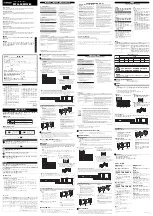
Section 3. Operation
3-5
condition for as long as it continues to receive a carrier indication and the tone or code that it
first decoded.
Repeater Hold Time
In order to reduce wear on the equipment and not clip out important parts of the messages
sent between users, the 37-MAX does not normally unkey immediately after the transmitting
radio user does. It keeps its own transmitter keyed for a short time in anticipation of another
radio in the same user group responding to the transmission that just ended. The duration of
this repeater hold time is set under system programming and the 37-MAX actually provides
two timers, a normal and an alternate. Which timer is used by a particular user is set under
user programming. The default values for these timers are Normal = 2 seconds and Alternate
= 3 seconds. Both of these timers can be set anywhere from zero to nine seconds, in whole
second increments.
Encode During Repeater Hold Time
Since the tone or code that is encoded by the panel during a radio user's transmission is
generated in the panel, it can be maintained independently during the repeater hold time.
Normally, the encode is dropped when the radio user unkeys to provide those units
monitoring the transmitter frequency of the repeater with a positive indication that the user
unkeyed, even though the repeater's carrier is still up. There are, however, valid operating
reasons for maintaining the encode for the entire repeater hold time. A common one would be
to support the use of radios that had a "busy-channel-lock-out" feature enabled in them. This
would both prevent new tones from interrupting conversations in progress, and require that
the originating tone or code continue during the hold time so that the radios in the correct
group could key up to respond. Whether or not the encoding continues during the repeater
hold time is programmable on a per-user basis.
Transmitting Morse Code Station ID
When a valid user has keyed up, the 37-MAX will check the Station ID Interval Timer to see
if the programmed interval has elapsed since the last ID. If it has, then the 37-MAX will
transmit the call sign programmed in Morse code at 30% of full channel deviation (so that the
radio users can continue to talk over the ID). This call sign can be up to eight characters long.
There are a number of parameters controlling the ID transmission that can be altered in the
field to suit the needs / licensing of the system, they are:
ID Interval
= The period of the ID Interval timer can be programmed from one to 90
minutes (in whole minutes), with the default being 15 minutes.
ID Mode
= The 37-MAX can be set to not ID at all, to ID only when the timer has
expired and there has been recent activity on the repeater, or to ID automatically
whenever the timer expires regardless of whether there has been any recent activity or
not. The default is to ID based on repeater activity. The 37-MAX will fail to ID if
there is no call sign programmed into the unit (the default is the call sign is blank),
even if one of the two ID modes has been selected.
Summary of Contents for 37-MAX
Page 72: ...Section 6 Repair 6 6 MODEL 37 MAX REPEATER PAL 702 9808A Schematic 1 3...
Page 73: ...Section 6 Repair 6 7 2 3...
Page 74: ...Section 6 Repair 6 8 3 3...
Page 75: ...Section 6 Repair 6 9 MODEL 37 MAX REPEATER PAL 702 9808A Silkscreen...
Page 76: ...APPENDIX A PROGRAMMING LOG A 1 OVERVIEW A 1 SYSTEM PROGRAMMING A 2 USER PROGRAMMING A 3...
















































